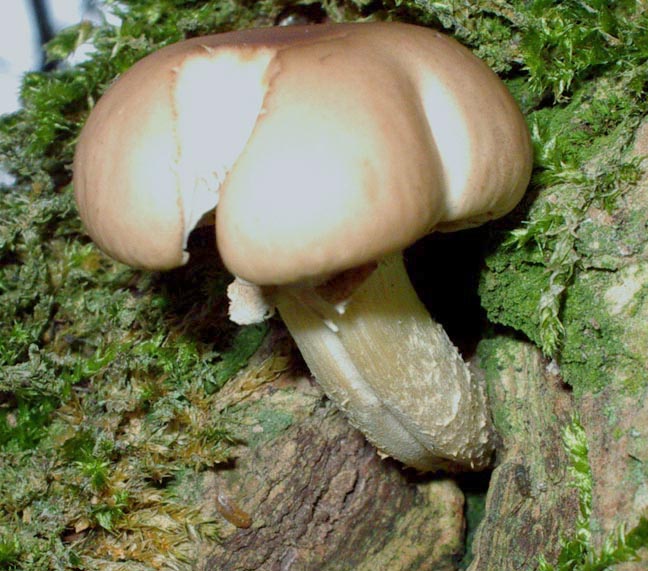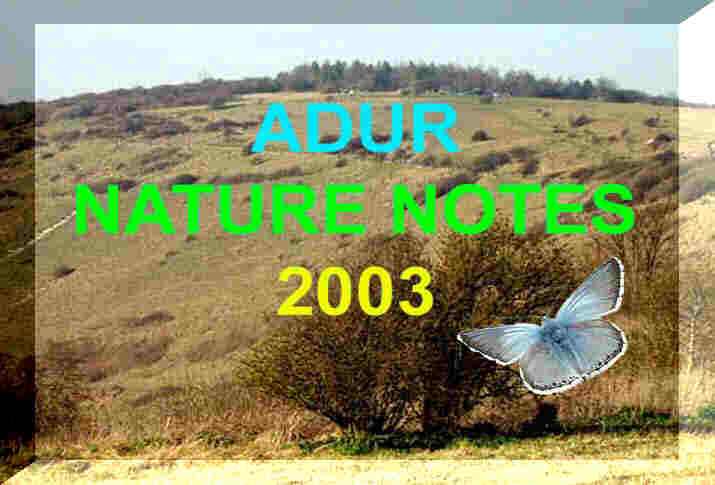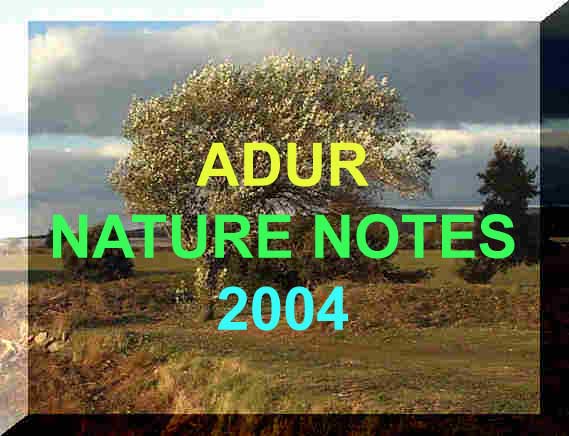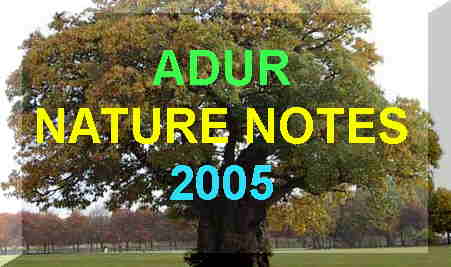including the Adur Levels, Mill Hill and cyclepath to Upper Beeding
Link to Reports from Autumn 2005 et seq
13
September 2005
On
the large pile of horse dung in Frampton's Field
(north of The Street, Old Shoreham) there was a large number of mushrooms.
 |
 |
They looked like Panaeolus sphinctrinus to my inexperienced eye. Second thoughts says they are Coprinus pachyspermus ?
4 September
2005
There
was Honey Fungus Mushrooms
(a harmful to living trees species) on the Hawthorn
scrub
immediately to the north of the lower slopes
of Mill Hill.
1 September 2005
3 August 2005
This small mushroom was found on the grass on the shingle near Old Fort. The photograph is probably not good enough for identification. The cap is about 25 mm in diameter. I neglected to measure the long stem of about 100 mm. It could be a Coprinus, one of the Ink Caps?
22
July 2005
The
Dryad's
Saddle, Polyporus
squamosus has grown again in the front
verge in Mill Hill Road. One large mushroom is already deteriorating. There
is one intact large mushroom.
30
May 2005
There
were half a dozen mushrooms in a tub of compost in a Shoreham
garden, which means they could have come from almost anywhere. They
look like Psathyrella candolleana.
| 28
May 2005
A solitary small mushroom was intact and quite firmly in place amongst the herbs on the lower slopes of Mill Hill. |
 |
 |
| 22
May 2005
On a Shoreham garden lawn This is the Haymaker, Panaeolous sp. |
 |
6 May
2005
There
were some more of the small mushrooms (illustrated on the right) on the
lower
slopes of Mill Hill, that I still have
not been able to identify. These two were next to the path. They appear
to be very new.
Previous
Report of what appear to be the same species
Fungi
Images on the Web
1
May 2005
After
the rain in the last week, two species of mushroom
emerged on the upper slopes of Mill
Hill.
The
first two were amongst the long grass and Germander
Speedwell amongst the scrub on the middle
slopes.
The
second smaller two were in very short turf and Rabbit faeces just above
the ridge. The caps of these second mushrooms were only 50% larger that
the balls of Rabbit faeces. This is probably the Dung Fungus, Stropharia
semiglobata.
 |
 |
 |
 |
 18
April 2005
18
April 2005
The
strange and unusual looking Morel
Mushroom,
Morchella esculenta,
was
seen on the side of the Pixie Path to
Mill
Hill. It looked dried out but I expect
they always look like this. There were small orange ants around the base
of the mushroom.
7 April
2005
The
following dried-out mushroom was found still upright on wood chips in a
flower bed near the main south-western gate of Buckingham Park, Shoreham.
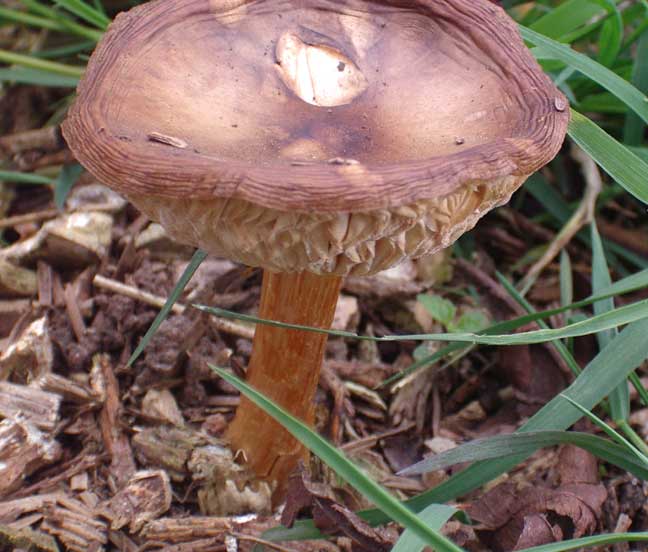 |
 |
It appears to be a common species that keeps on cropping up, but I am not sure of the species name. There were at least three, one with a cap at least 85 mm in diameter.
10
March 2005
On
the cyclepath south of the Cement Works,
on the rotten logs on the cyclepath verges there were numerous Trametes
bracket fungi and on the end of another log there were some King
Alfred’s Cakes; a distinctive blackish-coloured
fungus. This latter one was recorded in Shoreham for the first time.
 |
 |
Adur
Levels 2005
Adur
Fungi: Fruiting Bodies (Monthly Guide)
 29
December 2004
29
December 2004
An
old dessicated mushroom (photographed on the right) found on an old wooden
groyne on the shingle part of Shoreham Beach near the kiosk at the eastern
end of Widewater Lagoon car park was possibly
a species of Agrocybe.
It was incongruous on the beach, but it looked like a common species on
a poor condition, so I did not stop to examine it closely.
8 December
2004
Whilst
waiting for Eastern Avenue railway gates to open in Shoreham,
I spotted over a dozen dried out mushrooms
on the wood chips in the McDonald's car park. The cap diameter was estimated
at 40 mm in the largest specimen, although most of them were smaller to
30 mm. In the older specimens the conical cap became flat, with an upturned
rim. The stipe was brown in some of the mushrooms. On a small specimen
the cap was slightly conical and brown.
 |
 |
 |
|
 7
December 2004
7
December 2004
On
Spring
Dyke (TQ 209 068) next
to Miller's Stream
two species of mushroom were discovered:
 |
 |
 |
It was not until my departure (by the gate) that I discovered them. The red-orange mushroom growing from the reed strewn soil measured 22 cm cap diameter and it was 44 mm high and this is probably Tubaria furfuracea seen last winter (above far left). The other species (three images above, second from right to far right) looked much smaller, although the measurements of this tall mushroom were 90 mm high and a conical cap diameter of 18 mm, with a smaller specimen next to it which measured 65 mm high and a brown conical cap that was about 7 mm in diameter. This species came out of the soil and the base of the stipe was root-like as shown in the photograph on the far right. The smaller mushroom of the same species had pale cream-fawn gills that had not turned black.
Tubaria
furfuracea certainly looks likely.
The
other one is a Psathyrella
- if it is rooting it's Psathyrella
microrhiza, but rooting refers to
a small tap root, not lots of little white rootlets (which would be called
"strigose"). Must dig up carefully and then usually need to cut in half
(vertically) to see if it's rooting. If not rooting, then probably Psathyrella
gracilis. They both start out brown and
dry pale grey to dirty white, but young caps of Psathyrella
microrhiza are richer brown and more parabolic
whereas Psathyrella gracilis
is duller and more conical. Tubaria furfuracea,
Psathyrella
microrhiza and Psathyrella
gracilis all usually grow from sawdust,
although late in the seaon (i.e. December!)
Tubaria
furfuracea grows on soil - some people
call this another species (Tubaria hiemalis,
I think).
6 December
2004
Underneath
the Field Maple on
a footpath (between the Waterworks Road and
the Steyning Road the first mushrooms seen were a group of at least eight
intact
Common Ink Caps, Coprinus
atramentarius,
followed a group of about
six fresh Wood Blewit,  Lepista
nuda, to 90 mm cap diameter, and the miniature
white Clavulina. A
Mycena
mushroom (right) was still there, but the fruiting body look dried out
with pale brown gills.
Lepista
nuda, to 90 mm cap diameter, and the miniature
white Clavulina. A
Mycena
mushroom (right) was still there, but the fruiting body look dried out
with pale brown gills.
Images
30
November 2004
Underneath
the Field Maple on
a footpath (between the Waterworks Road and
the Steyning Road the first mushrooms seen were a group of three fresh
Common
Ink Caps, Coprinus atramentarius,
followed
almost immediately by a few small Mycena-like
mushrooms on a long stalk growing in soil,
and some remaining miniature white Clavulina.
The small mushrooms (photograph on the right) were probably Mycena
flavescens.
Next
to the Waterworks Road, there was a large old Straw
Mushroom, Volvariella
gloiocephala, with its distinctive
volva.
In
the scrub to the north of the the
lower
slopes of Mill Hill, the fruiting
bodies of two Honey Fungus, Armillaria,
were on a Hawthorn bush
and seen last year in the same place.
 |
 |
 |
 |
|
|
|
|
|
On the middle slopes (Triangle area) of Mill Hill two further small mushrooms were seen. The first solitary one (on the far right above) has not been identified. The second species, with at least two discovered, was the Pale Wax Cap, Hygrocybe pratensis var pallida. Then there was a group of the common bracket fungus Trametes versicolor on a stump.
22
November 2004
In
the scrubby area of Hawthorn
in the north-west of Mill
Hill Nature Reserve, a small yellowish
mushroom was spotted in the area cleared
by the South Downs Conservation Board. It was growing out of the soil,
near where the Hawthorn
and other bushes had been chopped down, with plenty of rabbit droppings.
Its cap diameter was 13 mm.
 |
 |
As this species was growing out of the soil it is thought to be Mycena flavescens. There is a similar species Mycena arcangeliana which grows on wood.
16
November 2004
Observations
indicated the creamy-white and brownish-cream
mushrooms with decurrent gills
on the upper and middle slopes of Mill
Hill photographed below were one and the same species. I have identified
this species (wrongly from earlier photographs)
as the Snowy Wax Cap,
Hygrocybe
virginea var.
virginea (=
Cuphophyllus
niveus) (or it could be the
Pale
Wax Cap,
Hygrocybe pratensis var
pallida) but this choice has not been confirmed.
This species has now been confirmed as the Pale Wax Cap, Hygrocybe berkeleyi, (known on the British Mycological List as Hygrocybe pratensis var pallida).
 |
 |
 |
 |
There was one other small brown mushroom in the Triangle area of Mill Hill, with some bracket fungi, Trametes versicolor, on a stump.
15
November 2004
The
Clitocybe
"Funnel
Cap" mushrooms were still present mostly in an
ivory white colour, (the brown ones had all disappeared), on the A27 road
embankment at the top of The Drive, Shoreham. Some of these appeared to
be the same mushrooms as before so some of them keep their white colour
for longer (at least two weeks?) than others.
11
November 2004
Another
small
white mushroom was discovered on the upper
and middle slopes of Mill Hill.
Mushroom
Report on Mill Hill (with images)
 |
 |
The
two small mushrooms in the photographs above only reached 30 mm in cap
diameter and most of the small clump, on the footpath approach to Mill
Hill from the Waterworks Road, were about
20 mm. They have not been identified.
The
spore print of this mushroom turned out to be white.
With
the latest photographs this species has now been identified as probably
being a Dermoloma, if blackening, Dermoloma magicum.
PS:
There was no sign of this mushroom turning black in colour.
This
latter species is a new one to the British
fungal list, not because it is rare though. This was difficult for
me to identify because all the pictures
available show Dermoloma with white or cream gills. All these specimens
had brown gills as shown in the photographs. The cap in the specimen above
is beginning to show white lines which were not present in the smaller
mushrooms. This seems to be a feature of this genus.
Later
(2014) the species
was thought to be the Crazed Cap, Dermoloma
cuneifolium.
8 -9
November 2004
In
the damp Field Maple
leaf litter and tree stumps on the footpath (between the Waterworks
Road and the Steyning Road, several mushrooms new to this area were
discovered.
 |
 |
These
included one Wood Blewit, Lepista
nuda, one tall mushroom with a white column
which had deteriorated, is probably Coprinus
niveus, and a brown mushroom with
a thin brittle brown stalk and brown gills with patches of red. This makes
me think it is the Bleeding Mycena,
Mycena
haematopus (? could be a similar species ?). The
spore print of this mushroom was light brown.
There
were also
Clavulina and
Clavaria
miniature
white fungi growing on mossy stumps and two very small
brown mushrooms, possibly Crepidotus variabilis, on
a twig that showed their gills on top.
Full
Report
4 November
2004
On
the footpath (between the Waterworks Road
and the Steyning Road, the clump of Shaggy
Parasols were not be seen and all but two
of the Common Ink Caps
were broken. This is a rarely used footpath and both fungi were in the
middle of the path. Instead there were at least four clumps of what appeared
to be Sulphur Tuft,
growing from a moss-lined tree stump imbedded in the soil and leaf litter.
There may be a few pine
stumps amongst the Field Maple.
 |
 |
 |
3 November
2004
 Generally,
on lawns, on grass verges, under town trees and in flower beds, mushrooms
proliferated and were certainly in much larger numbers than the dry summer
and autumn of 2004. November is the best month, but without veering out
of my way to look for them, the numbers and variety exceed my capacity
to record and identify all of them.
Generally,
on lawns, on grass verges, under town trees and in flower beds, mushrooms
proliferated and were certainly in much larger numbers than the dry summer
and autumn of 2004. November is the best month, but without veering out
of my way to look for them, the numbers and variety exceed my capacity
to record and identify all of them.
The
mushrooms were photographed and recorded on the following web page (click
on the text below this line):
Fungi
of the Urban Adur Area in November 2004
Identified and recognisable species included Volvariella gloiocephala, Glistening Ink-caps, Field Mushrooms, Parrot Wax Caps, Clitocybe, Leucoagaricus leucothites, Wood Blewits, a Blackening Ink Cap and the broken remnants of a species of a Honey Fungus Armillaria gallica, plus at least four species that I could not confidently put a name to.
2 November
2004
 Underneath
the Field Maple on
a footpath (between the Waterworks Road and
the Steyning Road the first mushrooms seen were Clavulina
and
Clavaria
miniature
white fungi followed by a group of three
Common
Ink Caps, Coprinus atramentarius, and
then more of these prominent mushrooms around the tree roots, followed
by two early
Shaggy Parasols, Macrolepiota
rhacodes, on the path.
Underneath
the Field Maple on
a footpath (between the Waterworks Road and
the Steyning Road the first mushrooms seen were Clavulina
and
Clavaria
miniature
white fungi followed by a group of three
Common
Ink Caps, Coprinus atramentarius, and
then more of these prominent mushrooms around the tree roots, followed
by two early
Shaggy Parasols, Macrolepiota
rhacodes, on the path.
Full
Report and Images
Adur
Fungi: Fruiting Bodies (Monthly Guide)
1 November 2004
Full Report
 Some
of the white mushroooms identified as Clitocybe on
the A27 road embankment at the top of The Drive, Shoreham, were beginning
to turn a brownish colour before disintegrating. The photograph on the
right shows the change of colour. There were still at least a dozen white
ones and probably more amongst the mosses, mixed herbs and discarded litter.
Some
of the white mushroooms identified as Clitocybe on
the A27 road embankment at the top of The Drive, Shoreham, were beginning
to turn a brownish colour before disintegrating. The photograph on the
right shows the change of colour. There were still at least a dozen white
ones and probably more amongst the mosses, mixed herbs and discarded litter. |
 |
 |
This white mushroom has been seen before on Lancing Ring meadows and may be early small fruiting bodies of a fungus that grows larger than these ones, the cap diameter of the larger of the two circles in the photograph measured 45 mm. Notice the decurrent gills that run down the stem. At the time of writing, I have not yet attempted to identify this species. They were found on the A27 road embankment at the top of The Drive, Shoreham. This is mostly gravel, a few mosses, herbs and woody plants including Cotoneaster.
 |
 |
 |

 |
The Wax Caps of yesterday (above, centre and right) had now grown and were large enough to try and identify them. The scarlet caps were at least 32 mm in diameter. The fungi are on the Pixie Path and they are not expected to last. There are 63 species of Hygrocybe found in Britain. They have been identified as the Dune Wax Cap, Hygrocybe conicoides. This mushroom is usually found near the sea. In this case it was two miles from the sea.
25
October 2004
The
was a small mushroom (above
left) on the muddy footpath approach to
Mill
Hill from the Waterworks
Road, with a conical cap 10 mm in diameter
when measured from the side. I have postponed trying to put an instant
name to this small mushroom, photographed and displayed on the right. This
is likely to be a species of wax cap, Hygrocybe.
The
spore print of this mushroom was white but this does not give an indication
to species as the first few Hygrocybe looked at in the book all
had white spore prints. This all seem strange to get a white spore print
from a brown mushroom.
Adur
Hygrocybe
Mycologue
22
October 2004
A
solitary and rather old mushroom
arose from some mixed plants next (between the path and river) to the cyclepath
south-east of the Toll Bridge.
 |
 |
The stem of the mushroom was measured at 10 cm high. The cap diameter was not measured, but this was estimated at 5 cm.
20
October 2004
In
the misty gloom of an overcast day at almost dusk, there was an unfamilar
white mushroom which had been broken off its stem and lay loose on the
long grass on the southern part of Mill
Hill.
 |
 |
It was about the average size of a flat commercial mushroom, estimated at 65 mm cap diameter. The gills are more widely spaced than other white mushrooms seen on the downs. This could be the result of age and deterioration though.
On
the
lower slopes of Mill
Hill there were a couple of species of mushrooms,
a handful of a white species (now turning slightly brown) and a smaller
one with brown gills. Although this one does not show a ring, it is very
similar to the white one below, with a stem that is easily broken.
 |
 |
The photograph above is an old specimen of Leucoagaricus leucothites.
The
smaller brown one had a cap 20 mm across. The spore print for the small
brown mushroom was dark brown (my first successful spore print).
How
to take a Spore Print (Link)
Mushroom
Images from Mill Hill
Small
Brown Mushroom (Images)
11
October 2004
A
white mushroom was discovered amongst
the Horseshoe Vetch on the lower slopes of
Mill
Hill. This is the one with a ring.
More
Images
Images
for ID (JJW)
This
species is almost certainly the White Dapperling,
Leucoagaricus
leucothites. I do not think that the common name is actually used
for this frequently encountered species?
 |
 |
The
Dryad's
Saddle, Polyporus
squamosus, has been smashed and all
the mushrooms removed from the front garden in Mill Hill Road. The photographs
below show the underside and the stipe (stem).
 |
 |
6 October 2004
 5
October 2004
5
October 2004
4
October 2004
The
designated footpath (between the Waterworks Road
and the Steyning Road, Old Shoreham) produced a solitary
mushroom amongst the leaf litter of Field
Maple
with an occasional small pine.
It stood upright measured 80 mm above the ground, attached to a almost
hidden root in the middle of the path. It gills were white and it is shown
in the photographs below. The cap was 55 mm in diameter. It lacked a ring
and did not have either a
volvaor
a bulbous base. It was quite strong and it readily sprang back into place
after I bent the mushroom back to take photographs of its gills. The second
picture shows the mushroom to be partly eaten or damaged. It did not have
a noticeable smell. The surface of the cap was slightly slimy, but I attributed
this to the rain.
This
species was the Rooting Shank, Oudemansiella
radicata. This species was top of my short list for identification.
By
7
October 2004, this mushroom had dried out.
Wild Mushroom Pickers' Code of Conduct
Ectomycorrhizal Fungi
Fungal Reference List
 |
 |
 |
There
was also one more clump of the Ink Cap
Mushrooms seen on 26
September 2004 and shown again in the
image second from the left below. The
gills had turned black.

There
was one mushroom on the steeper slopes of Mill
Hill. This mushroom still remains unidentified.
Because
the Dryad's Saddle (Toadstool) mentioned below was next to a dangerous
(because of motor traffic) part of Mill Hill Road, I may have overlooked
one of the Ink Cap Mushrooms
below the larger fungus. These look like the Glistening
Inkcap, Coprinus
micaceus.
 |
 |
 |
There was a third fungus with a fruiting body that had shrivelled up as well, although this is what a Dryad's Saddle eventually succumbs too. The black stem is characteristic.
3 October
2004
The
same mushrooms found on 30
June 2004 were again discovered in the
twitten
between Ravensbourne Avenue and Buckingham Park after the recent rain.
The gills were white in these closed mushrooms. They were firm to touch
and felt just like commercial mushrooms.
1
October 2004
A
huge toadstool has grown on a tree stump in Mill Hill Road, Old Shoreham.
It measured 45 cm in length. This is the Dryad's Saddle, Polyporus
squamosus, and it has been seen before
in the same location. The books record usual sizes up to 30 cm only, but
there have been reports of up to 60 cm.
 |
 |
 |
A small
collection of probable Panaeolus sphinctrinus
were
on the road verge next to a cattle field just north of Mill
Hill bridge (bridge over the A27). There is a common name of Hoop-petticoat
Fungus, but I cannot see this name becoming popular because of its
affinity for living on or near dung.
Names
of Fungi
 |
 |
 |
 |
 |
 |
26
September 2004
On
a footpath (between the Waterworks Road and
the Steyning Road, Old Shoreham) under a canopy of Field
Maple a strange
mushroom poked out of the leaf litter.
Its gills had a pale blue-grey hue which is unusual. It was about the size
of a commercial flat mushroom, about 50 mm in diameter. This is one of
the Ink Cap Mushrooms,
Coprinus.
 |
 |
 |
24
September 2004
The
following mushrooms were discovered, three of the first species and one
unidentified, and without a stem, on
the lower slopes of Mill
Hill south of the Tor Grass zone. I again did not measure the mushrooms,
but the first one was about the size of a commercial flat mushroom, i.e.
variable about 60 mm cap diameter. The gills are white, but it looks like
the species that has turned brown and shown below.
 |
 |
 |
|
|
Mushroom in the short herbland |
|
2
September 2004
This
solitary mushroom poked
out of the short herbland next to a Rabbit
warren just below the ridge on the lower slopes
of Mill Hill. It was not measured,
but it was estimated to be about 85 mm in diameter. I had a guess that
this could be a species of Lepiota.
This species was later identified as Leucoagaricus
leucothites.
 |
 |
 Still
overcast after the deluge of 24 August 2004,
the soaking had resulted in mushrooms appearing
of three different species, probably Conocybe in the horse's
field south-west of the bridge to Mill
Hill, a still unidentified mushroom on the lower
slopes and the first species I have discovered on the bare earth under
the canopy of broad-leaved (Italian Alder, Beech, Norway Maple) and evergreen
(Corsican Pine) trees in the copse on
the top of the hill. This latter species illustrated on the far right underneath
has not yet been identified although it resembled the edible
Field Mushroom in appearance, although the
gills were lighter in colour. There was a deteriorated specimen
with darker, almost black gills. They were inconspicuous as a white dome
was almost parallel with the surface of the soil and the beginnings of
the leaf litter were distracting. This mushroom
has been confirmed as the Field Mushroom,
Agaricus
campestris.
Still
overcast after the deluge of 24 August 2004,
the soaking had resulted in mushrooms appearing
of three different species, probably Conocybe in the horse's
field south-west of the bridge to Mill
Hill, a still unidentified mushroom on the lower
slopes and the first species I have discovered on the bare earth under
the canopy of broad-leaved (Italian Alder, Beech, Norway Maple) and evergreen
(Corsican Pine) trees in the copse on
the top of the hill. This latter species illustrated on the far right underneath
has not yet been identified although it resembled the edible
Field Mushroom in appearance, although the
gills were lighter in colour. There was a deteriorated specimen
with darker, almost black gills. They were inconspicuous as a white dome
was almost parallel with the surface of the soil and the beginnings of
the leaf litter were distracting. This mushroom
has been confirmed as the Field Mushroom,
Agaricus
campestris. |
 |
 |
|
of Mill Hill |
mixed copse on Mill Hill |
|
The illustrated Agaricus species of mushroom in the photographs immediately above (centre and right) looks like the Field Mushroom, Agaricus campestris. There are other species it could be including the Wood Mushroom, Agaricus silvicola, the less common Agaricus bitorquis or the coastal species Agaricus bernardii. This mushroom did not have a noticeable smell.




































